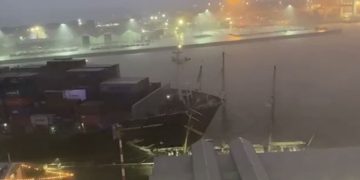A report released Monday on the April 16, 2014 sinking of the Sewol ferry, which left 304 dead or missing, concluded that the disaster was caused by structural failures of the vessel.
The report was issued by the Mokpo branch of the state-run Korea Maritime Safety Tribunal (KMST). It highlighted that the ferry’s instability stemmed from a malfunctioning steering system and alterations made to the ship, which compromised its structural integrity. The KMST’s investigation dismissed external factors, such as a collision with another vessel, as contributing to the ship’s capsizing, as confirmed in the The Korean Herald’s coverage of the findings.
The ferry, which was carrying 476 people and approximately 2,215 tons of cargo, was sailing off the coast of Jindo-gun, South Jeolla Province, when it tilted and capsized. The Korean Herald reported that the ferry had over twice the amount of cargo that it was legally allowed to carry, which exacerbated its instability.
According to the KMST, the rapid turn that caused the ship to capsize was not due to human error but rather a malfunction of the steering system. Additionally, the ship had been remodeled, making it larger with a higher hull, which lowered its restoring force and contributed to the vessel’s inability to right itself during the turn.
The KMST’s report also noted that the cargo on board was not properly secured, causing it to shift during the turn and making it impossible for the ship to remain afloat. Furthermore, the report emphasized the lack of proper rescue efforts from the crew. Lee Joon-seok, the captain of the ferry, abandoned the ship without ensuring the safety of the passengers. He instructed the crew to tell passengers to stay in place, wasting critical time that could have been used for evacuation, according to The Korean Herald. The KMST confirmed that these actions, or lack thereof, played a significant role in the high death toll.
According to The Korean Herald, the report concluded that the captain, along with several other crew members, were criminally responsible for the tragedy. Lee was convicted of murder by omission and is currently serving a life sentence. Other crew members, including the first and second officers and the chief engineer, were also convicted. The KMST’s findings led to the cancellation of the licenses of five sailors, including the captain, and the suspension of licenses for three others.
The ferry’s operator, Cheonghaejin Marine Co., was ordered to address the safety lapses identified in the investigation. However, as The Korean Herald reported, Cheonghaejin Marine Co. has appealed the decision, and the case is still ongoing.






























































